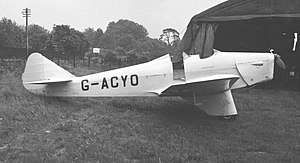Miles Hawk Major
The Miles Hawk Major was a 1930s British two-seat light monoplane developed by Miles Aircraft from the Miles Hawk.
| Hawk Major | |
|---|---|
 | |
| Miles M.2H Hawk Major at White Waltham Airfield, near Maidenhead Berkshire, in June 1953 | |
| Role | Two-seat touring and racing monoplane |
| Manufacturer | Miles Aircraft Limited |
| Designer | Frederick George Miles |
| First flight | 1934 |
| Primary user | Royal Air Force |
| Number built | 64 |
| Developed from | Miles Hawk |
Design and development
The Hawk Major was a variant of the Miles M.2 Hawk, developed by F.G. Miles to take advantage of the new inverted de Havilland Gipsy Major engine. Other changes included metal (instead of wood) engine mounts and streamlined undercarriage. The prototype M.2F Hawk Major) was first flown in 1934 and went on to second place in the 1934 King's Cup Race at an average speed of 147.78 mph. A racing version was developed as the one-off single-seat M.2E Gipsy Six Hawk with a 200 hp de Havilland Gipsy Six engine. The production Hawk Major had the 130 hp de Havilland Gipsy Major engine. The aircraft sold well to private owners, including two that were fitted with smoke generators to allow them to be used as skywriters. An improved version (the M.2H) with a trailing edge flap replaced the M.2F on the production line. A number of special one-off racing versions were also built.[1] In October 1934, Squadron Leader Malcolm Charles McGregor flew a Hawk Major from RAF Mildenhall to Melbourne, Australia in 7 days, 15 hours while competing in the MacRobertson Air Race.[2][3] In 1936 Miles Hawk Speed Six, G-ADOD was entered into the Schlesinger Race from Portsmouth to Johannesburg and flown by A. E. Clouston who nearly made it all the way to Johannesburg but had to make a crash landing due to engine trouble 150 miles south of Salisbury.[1]
In 1935, an improved version for training use was developed as the Miles Hawk Trainer.
Variants
- M.2F Hawk Major
- Production version powered by a de Havilland Gipsy Major engine.
- M.2G Hawk Major
- Three-seat cabin version, one built.
- M.2H Hawk Major
- Production version powered by a de Havilland Gipsy Major engine.
- M.2K Hawk Major
- Powered by a 105 hp Cirrus Hermes II engine, one built.
- M.2M Hawk Major
- Three-seat version powered by a de Havilland Gipsy Major engine, two built.
- M.2P Hawk Major
- Dual control version powered by a de Havilland Gipsy Major engine, three built.
- M.2R Hawk Major de Luxe
- Racing version powered by a de Havilland Gipsy Major engine, two built.
- M.2S
- Long-range version Powered by a 150 hp Blackburn Cirrus Major engine.
- M.2T
- Long-range single-seater powered by 150 hp Blackburn Cirrus Major engine, two built.
Miles Hawk Speed Six

The Speed Six was a single-seat racing variant of the Hawk Major fitted with the larger six-cylinder Gipsy Six engine. Only three were made, each tailored to specific requirements.
- M.2E (Initially the Miles Gipsy Six Hawk)
- Powered by a 200 hp de Havilland Gipsy Six engine.
- M.2L Hawk Speed Six G-ADGP
- Powered by a 200 hp de Havilland Gipsy Six 1F engine.
- M.2U Hawk Speed Six G-ADOD
- Powered by a de Havilland Gipsy Six R engine.
Survivors
- M.2L Speed Six G-ADGP is airworthy in 2020 and in the Shuttleworth Collection based at Old Warden.
- M.2H Hawk Major (DG590) (Civilian Registration was G-ADMW) at Montrose Air Station Heritage Centre, Montrose, Angus, Scotland, under restoration as of 2020.[4]
- M.2H Hawk Major registered G-ADAS and based at Museu TAM, São Carlos, São Paulo, Brazil. This exemplar is the only one that have the capacity of fly.
Specifications (M.2F)
General characteristics
- Capacity: Two
- Length: 24 ft 0 in (7.32 m)
- Wingspan: 33 ft 0 in (10.06 m)
- Height: 6 ft 8 in (2.03 m)
- Wing area: 169 sq ft (15.70 m2)
- Empty weight: 1,150 lb (522 kg)
- Gross weight: 1,850 lb (840 kg)
- Powerplant: 1 × de Havilland Gipsy Major , 200 hp (149 kW)
Performance
- Maximum speed: 150 mph (241 km/h, 130 kn)
- Range: 560 mi (901 km, 490 nmi)
- Service ceiling: 20,000 ft (6,100 m)
- Rate of climb: 1,000 ft/min (5.1 m/s)
References
| Wikimedia Commons has media related to Miles Hawk Major. |
Notes
- "1936 | 2706 | Flight Archive". Flightglobal.com. 8 October 1936. Retrieved 26 October 2016.
- "aero club | baby ruth | macpherson robertson | 1934 | 1072 | Flight Archive". Flightglobal.com. 18 October 1934. Retrieved 26 October 2016.
- "lockheed vega | 1934 | 1075 | Flight Archive". Flightglobal.com. 18 October 1934. Retrieved 26 October 2016.
- Dunnell, Brian (August 2020). "Workshop: Going the Extra Miles". Aeroplane. Vol. 48 no. 8. pp. 14–18. ISSN 0143-7240.
Bibliography
- Amos, Peter. and Brown, Don Lambert. Miles Aircraft Since 1925, Volume 1. London: Putnam Aeronautical, 2000. ISBN 0-85177-787-2.
- Brown, Don Lambert. Miles Aircraft Since 1925. London: Putnam & Company Ltd., 1970. ISBN 0-370-00127-3.
- The Illustrated Encyclopedia of Aircraft (Part Work 1982–1985). Orbis Publishing.
- Jackson, A.J. British Civil Aircraft since 1919, Volume 3. London: Putnam & Company Ltd., 1974. ISBN 0-370-10014-X.